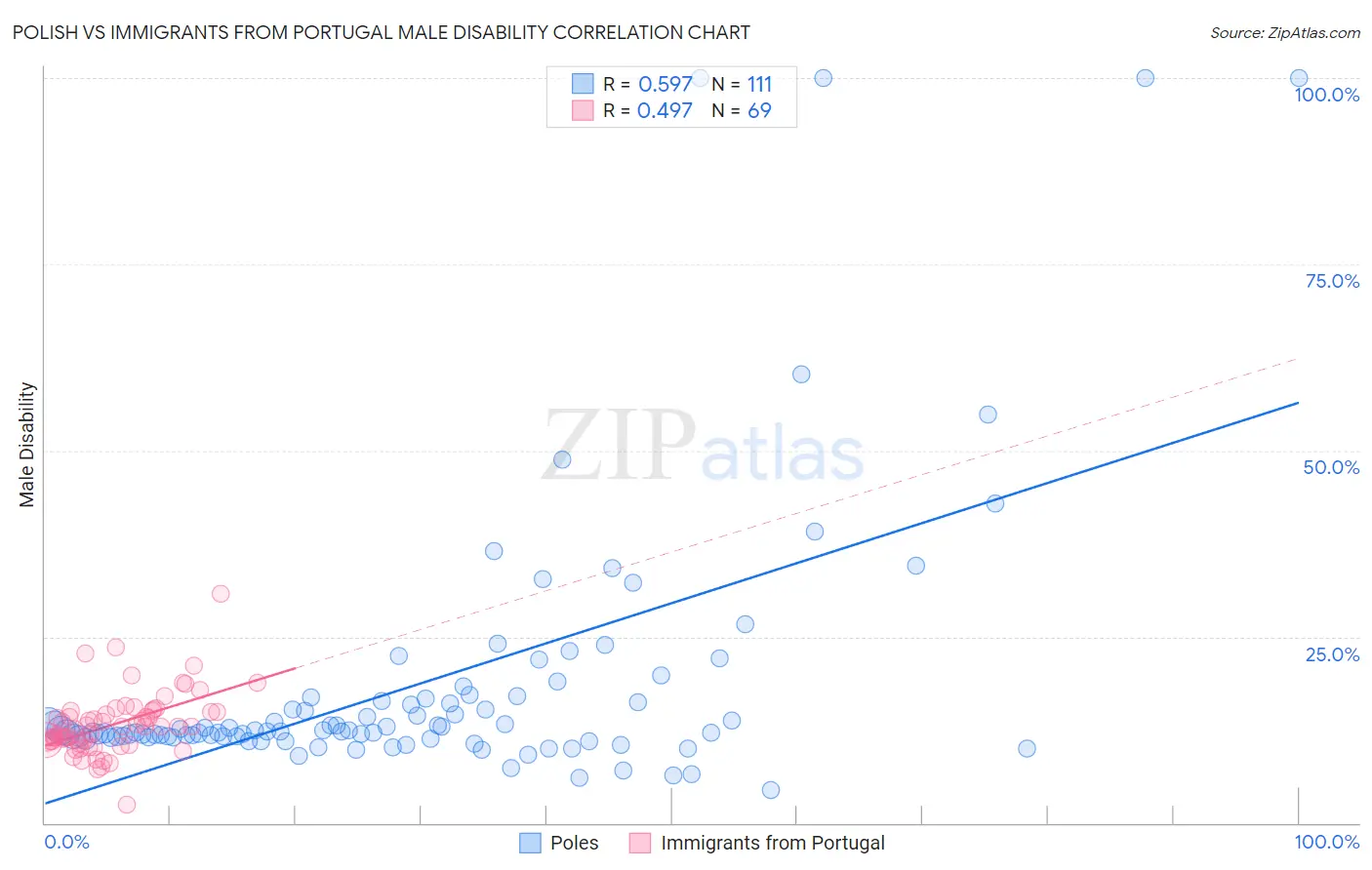Polish vs Immigrants from Portugal Male Disability
COMPARE
Polish
Immigrants from Portugal
Male Disability
Male Disability Comparison
Poles
Immigrants from Portugal
12.0%
MALE DISABILITY
0.7/ 100
METRIC RATING
248th/ 347
METRIC RANK
12.3%
MALE DISABILITY
0.1/ 100
METRIC RATING
265th/ 347
METRIC RANK
Polish vs Immigrants from Portugal Male Disability Correlation Chart
The statistical analysis conducted on geographies consisting of 560,313,997 people shows a substantial positive correlation between the proportion of Poles and percentage of males with a disability in the United States with a correlation coefficient (R) of 0.597 and weighted average of 12.0%. Similarly, the statistical analysis conducted on geographies consisting of 174,781,482 people shows a moderate positive correlation between the proportion of Immigrants from Portugal and percentage of males with a disability in the United States with a correlation coefficient (R) of 0.497 and weighted average of 12.3%, a difference of 2.3%.

Male Disability Correlation Summary
| Measurement | Polish | Immigrants from Portugal |
| Minimum | 4.3% | 2.4% |
| Maximum | 100.0% | 30.8% |
| Range | 95.7% | 28.4% |
| Mean | 18.7% | 13.2% |
| Median | 12.3% | 12.9% |
| Interquartile 25% (IQ1) | 11.5% | 11.0% |
| Interquartile 75% (IQ3) | 16.7% | 15.0% |
| Interquartile Range (IQR) | 5.2% | 3.9% |
| Standard Deviation (Sample) | 18.4% | 4.2% |
| Standard Deviation (Population) | 18.3% | 4.2% |
Demographics Similar to Poles and Immigrants from Portugal by Male Disability
In terms of male disability, the demographic groups most similar to Poles are Hungarian (12.0%, a difference of 0.18%), Danish (11.9%, a difference of 0.36%), Immigrants from Yemen (12.0%, a difference of 0.36%), Bangladeshi (12.0%, a difference of 0.42%), and German Russian (12.0%, a difference of 0.42%). Similarly, the demographic groups most similar to Immigrants from Portugal are Hawaiian (12.3%, a difference of 0.020%), Nepalese (12.2%, a difference of 0.46%), Canadian (12.2%, a difference of 0.49%), Norwegian (12.2%, a difference of 0.69%), and Slavic (12.2%, a difference of 0.71%).
| Demographics | Rating | Rank | Male Disability |
| Danes | 0.9 /100 | #246 | Tragic 11.9% |
| Hungarians | 0.8 /100 | #247 | Tragic 12.0% |
| Poles | 0.7 /100 | #248 | Tragic 12.0% |
| Immigrants | Yemen | 0.5 /100 | #249 | Tragic 12.0% |
| Bangladeshis | 0.5 /100 | #250 | Tragic 12.0% |
| German Russians | 0.5 /100 | #251 | Tragic 12.0% |
| Slovenes | 0.5 /100 | #252 | Tragic 12.0% |
| Guamanians/Chamorros | 0.5 /100 | #253 | Tragic 12.0% |
| British | 0.4 /100 | #254 | Tragic 12.1% |
| Chinese | 0.4 /100 | #255 | Tragic 12.1% |
| Swiss | 0.3 /100 | #256 | Tragic 12.1% |
| Europeans | 0.3 /100 | #257 | Tragic 12.1% |
| Basques | 0.3 /100 | #258 | Tragic 12.1% |
| Belgians | 0.3 /100 | #259 | Tragic 12.1% |
| Swedes | 0.3 /100 | #260 | Tragic 12.1% |
| Slavs | 0.2 /100 | #261 | Tragic 12.2% |
| Norwegians | 0.2 /100 | #262 | Tragic 12.2% |
| Canadians | 0.2 /100 | #263 | Tragic 12.2% |
| Nepalese | 0.2 /100 | #264 | Tragic 12.2% |
| Immigrants | Portugal | 0.1 /100 | #265 | Tragic 12.3% |
| Hawaiians | 0.1 /100 | #266 | Tragic 12.3% |